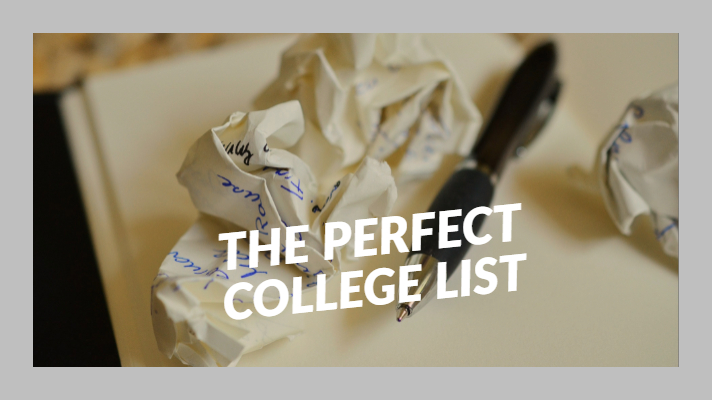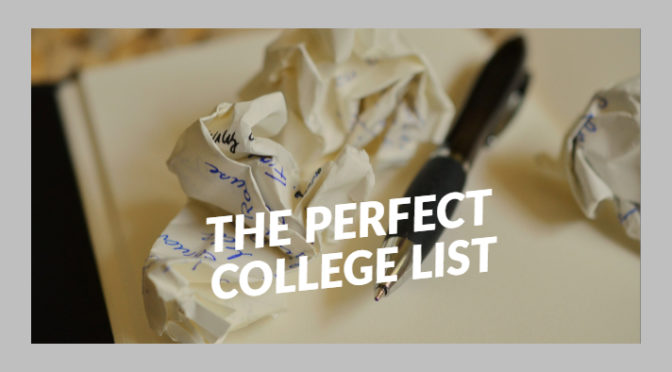
Did you know there are more than 4,000 four-year colleges and universities in the United States? That can make choosing a college overwhelming. But there is a college to fit your dreams – and finding it starts with the right list of schools where you plan to apply.
Your college list is the basis for every decision regarding college. Without a good list, it’s impossible to make a clearly logical and well-informed college choice. You should begin your college list during your junior year of high school. By the beginning of your senior year, you should have a final list for college applications.
The “Fit” Questions
How do you start a dream list? A good college list should have three “fit” criteria: financial fit, academic fit and emotional fit. Consider each school by asking these “fit” questions:
- Financial Fit-Does the college fit into your family’s budget?
- Academic Fit-Does the college fit into your academic aspirations?
- Emotional Fit-Can you see yourself attending college there?
Seven More Questions to Use as a Reality Check
Once you’ve answered the “fit” questions, dig deep and ask yourself these questions:
- Are you choosing a college to follow a boyfriend or girlfriend?
- Are you choosing a college to follow a best friend?
- Are you choosing a college because you follow the sports team?
- Are you choosing a college because it’s “fun”?
- Are you choosing a college because of location?
- Are you choosing a college because of its reputation?
- Are you choosing a college based on someone else’s opinion?
Divide Your College List Into These Categories
Once you’ve answered all those questions, you’re ready to begin your list, which should always include the Dream Team, the Best Bets and some Sure Things (also known as reach schools, best fit schools and safety schools).
The Dream Team
Your dream colleges should be a reach but not impossible. Those colleges have very low acceptance rates. I’m all for dreaming, but when it comes to a college list, practicality and logic reign.
The Best Bets
The colleges on this part of the list are colleges that would put you at the top of the applicant pool. It’s not all about the money, but money sure does make the final decision easier.
The Sure Things
Carefully consider the choices and make sure that these colleges are colleges you really want to attend. It will relieve pressure and stress if they offer you admission.
Consider This Important College Data
Now that you know which colleges to put on your college list, how do you choose the right ones? What criteria do you use to populate your list? Where do you find the best information, or statistics, to help you make your list?
Two good sources for college statistics are College Navigator and College Data. These two resources will help you make an informed college choice. Numbers aren’t everything, but consider these important stats when you are looking at schools
Rankings
Never rely solely on one set of rankings. Use the comparison tools to make a wise college choice.
Financial aid percentages
If you need financial aid, a college with a low percentage of merit aid should be eliminated from your list.
Acceptance rates
Look for colleges with high acceptance rates. Better yet, look for the colleges where you would be a top applicant in the applicant pool. This translates into more merit aid in the financial aid package.
Faculty-student ratio
If you’re looking at a big school, consider the size of the program that interests you. You may get more personalized attention in a major with fewer students.
Freshman retention rate
If schools you’re considering have a low freshman retention rate, there’s a reason. Some colleges do a great job of taking care of their freshmen; some don’t.
Graduation rate
When you research the college, look up their graduation rates. Low rates could be a red flag.
Average indebtedness
If the average student indebtedness is high, and you need financial aid, this college might not make the final list.
Percentage of students employed after graduation
Colleges with a high percentage of unemployed graduates should be avoided by students who need to incur high student loan debt.
Other Important Stuff to Think About
- Study styles: Are you more comfortable in a structured class or doing independent study?
- Money: Your budget plays a huge factor in the decision process.
- Size: Do you want small class sizes, or does it matter?
- Location: Do you want to go away to college or stay close by or even live at home?
- Extracurriculars: Are there activities that are crucial to having a positive college experience (for example, working on a campus newspaper, participating in intramural sports, studying abroad)?
- Academics: Is there a specific major you are interested in, or will a liberal arts degree do?
- Career focus: Do you need to consider a school that offers specialized degrees like culinary arts or fashion design?
- Sports: Does the school have a huge sports program, or do sports have little impact on your decision?
- Competitive or noncompetitive: Do you have the resume that will ensure acceptance to a competitive college like Stanford or Princeton?
- Specialized programs: Do you want to work in a specific field?
As you can easily see, there’s more to refining a college list than picking a college with Greek life or college sports rankings. It’s a place you will call home, and you need to feel comfortable there. Once you’ve determined that a college meets all your criteria, add it to the list. It’s a keeper!
For details on each category and more information on how to populate your college list, read the original article written for TeenLife Magazine: How to Put Together a College List that Finds the Perfect Fit.


A college is so important for a student. If a college is not easy for a student then he or she will not study well. The budget also plays an important role. Can you prefer any college for higher study with all the facilities?
Yes! I find so many students and their families fail to consider “fit” from all the angles, when choosing a college.